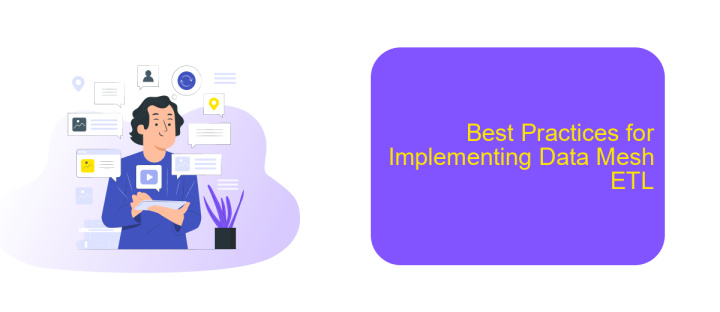Data Mesh ETL
Data Mesh ETL represents a paradigm shift in data architecture, emphasizing decentralized ownership and domain-oriented data management. Unlike traditional ETL processes, Data Mesh promotes scalability and flexibility by empowering cross-functional teams to manage and transform data within their own domains. This article explores the principles of Data Mesh ETL, its benefits, and how it redefines data integration in modern enterprises.
Introduction to Data Mesh ETL
Data Mesh ETL is an emerging paradigm that redefines how data is processed and integrated across an organization. Unlike traditional ETL processes, Data Mesh ETL decentralizes data ownership and promotes a more scalable and flexible approach to data management. This model is designed to address the challenges of data silos and bottlenecks by distributing data responsibilities to individual teams.
- Decentralized Data Ownership
- Scalable Data Integration
- Flexibility in Data Processing
- Improved Data Quality and Governance
To facilitate seamless integration in a Data Mesh ETL framework, services like ApiX-Drive can be instrumental. ApiX-Drive offers a user-friendly platform to automate data workflows and integrate various applications without requiring extensive coding skills. This makes it easier for teams to manage their data pipelines and ensure that data flows efficiently across different domains. By leveraging such tools, organizations can enhance their data strategy and achieve better outcomes.
Benefits and Challenges of Data Mesh ETL

Data Mesh ETL offers numerous benefits, including enhanced scalability, improved data quality, and greater flexibility. By decentralizing data ownership, teams can manage and process their data independently, leading to faster decision-making and innovation. This approach also promotes data democratization, allowing more stakeholders to access and utilize data effectively. Additionally, integrating services like ApiX-Drive can streamline the process, enabling seamless data flow across various platforms and ensuring consistency and reliability.
However, implementing Data Mesh ETL presents several challenges. One significant hurdle is the complexity of managing decentralized data environments, which can lead to inconsistencies and governance issues. Ensuring proper data integration and synchronization across multiple domains requires robust infrastructure and skilled personnel. Moreover, the initial setup and ongoing maintenance can be resource-intensive. Leveraging tools like ApiX-Drive can mitigate some of these challenges by automating integrations and providing a unified interface for managing data workflows.
Key Concepts and Components of Data Mesh ETL

Data Mesh ETL is a paradigm shift in how we handle data extraction, transformation, and loading processes. Unlike traditional ETL pipelines, Data Mesh ETL emphasizes decentralization, domain-oriented data ownership, and self-serve data infrastructure. This approach aims to democratize data and make it more accessible across various domains within an organization.
- Domain-oriented Data Ownership: Each domain team has complete ownership of their data, ensuring data quality and relevance.
- Data as a Product: Data is treated as a product with its own lifecycle, including development, maintenance, and deprecation phases.
- Self-Serve Data Infrastructure: Tools and platforms like ApiX-Drive enable teams to set up and manage their own data pipelines without relying on central IT teams.
- Federated Computational Governance: A unified governance model ensures compliance and standardization across decentralized data sources.
By implementing Data Mesh ETL, organizations can achieve greater scalability and flexibility in their data operations. Services like ApiX-Drive facilitate seamless integration and automation, empowering domain teams to manage their data more efficiently. This holistic approach not only improves data quality but also accelerates decision-making processes by providing timely and relevant insights.
Best Practices for Implementing Data Mesh ETL

Implementing Data Mesh ETL effectively requires a clear understanding of its principles and best practices. The decentralized nature of Data Mesh calls for a shift from traditional monolithic ETL pipelines to a more distributed approach, emphasizing domain ownership and data as a product.
To ensure a successful implementation, organizations should focus on empowering domain teams with the right tools and frameworks. This involves providing them with the autonomy to manage their own data pipelines while adhering to overarching governance policies. Collaboration and communication between teams are crucial to maintain data quality and consistency.
- Adopt a domain-oriented design to decentralize data ownership.
- Implement self-serve data infrastructure to empower domain teams.
- Ensure strong data governance to maintain consistency and quality.
- Utilize integration services like ApiX-Drive for seamless data flow.
- Promote a culture of collaboration and communication among teams.
By following these best practices, organizations can leverage the full potential of Data Mesh ETL, ensuring scalability, flexibility, and improved data quality. Tools like ApiX-Drive can facilitate integration, making it easier for domain teams to manage their data pipelines efficiently.
- Automate the work of an online store or landing
- Empower through integration
- Don't spend money on programmers and integrators
- Save time by automating routine tasks
Case Studies and Future Trends of Data Mesh ETL
Several companies have successfully implemented Data Mesh ETL, showcasing its potential to revolutionize data management. For instance, a global retail giant leveraged Data Mesh to decentralize their data architecture, enabling individual departments to manage their own data pipelines. This approach not only improved data quality but also accelerated decision-making processes. Another case involves a leading financial institution that adopted Data Mesh ETL to enhance their fraud detection systems. By decentralizing data ownership, they could quickly adapt to emerging threats and improve their overall security posture.
Looking ahead, the future of Data Mesh ETL appears promising with several trends on the horizon. One significant trend is the integration of automated ETL services like ApiX-Drive, which streamline the process of connecting various data sources and applications. This will further democratize data access and empower non-technical users to build and manage their own data workflows. Additionally, advancements in AI and machine learning are expected to enhance the capabilities of Data Mesh ETL, enabling more sophisticated data processing and analytics. As organizations continue to embrace these innovations, Data Mesh ETL will likely become a cornerstone of modern data strategies.
FAQ
What is Data Mesh ETL?
How does Data Mesh ETL differ from traditional ETL?
What are the benefits of using Data Mesh ETL?
How can I automate and integrate Data Mesh ETL processes?
What challenges might I face when implementing Data Mesh ETL?
Apix-Drive will help optimize business processes, save you from a lot of routine tasks and unnecessary costs for automation, attracting additional specialists. Try setting up a free test connection with ApiX-Drive and see for yourself. Now you have to think about where to invest the freed time and money!


